Seaton Delaval Hall - Surprise!
On Monday of the week we were in the UK we decided to visit some National Trust properties. One of the closest to where we were staying is a place called Seaton Delaval Hall. It's a stately home, but of a different sort than we usually visit; it suffered a terrible fire in 1822 and is in the process of being conserved. The conservation of Seaton Delaval Hall is the number one priority of the National Trust this year. They won't rebuild it or furnish it beyond what is currently there. They are working to keep it from deteriorating more so it can be enjoyed for generations to come.It's a bit eerie to walk into what, from the outside, looks like another magnificent stately home in the UK only to find a burned out shell of a home. What is interesting is that one can see how the building was constructed. We walked around the main hall, in awe of the damage that the fire had done, and then moved into a wing of the house where the family lived after the fire. As Seaton Delaval Hall wasn't the permanent home of the family who owned it, they were able to live in "smaller" quarters when they came to visit.This is where we came across some truly wonderful needlework! Whenever we go to visit a property in the UK, I do research first to see if there is any needlework of any kind to see. I hadn't found any reference to needlework on the National Trust web site, nor on any other web site about Seaton Delaval Hall, so I wasn't expecting to see anything particularly special. I was wrong!We came up the stairs and into a long gallery where there is a set of two sofas and eight chairs. According to the guide book they are walnut, each with a padded back and seat upholstered in needlework. The pictures tell the story of Sir John Astley, King's Champion, who was victorious in two mid 15th century combats. According to the guide in the house, they were done in 1740. Before the American Revolution. A long time ago. And they still looked so bright and fresh!
We walked around the main hall, in awe of the damage that the fire had done, and then moved into a wing of the house where the family lived after the fire. As Seaton Delaval Hall wasn't the permanent home of the family who owned it, they were able to live in "smaller" quarters when they came to visit.This is where we came across some truly wonderful needlework! Whenever we go to visit a property in the UK, I do research first to see if there is any needlework of any kind to see. I hadn't found any reference to needlework on the National Trust web site, nor on any other web site about Seaton Delaval Hall, so I wasn't expecting to see anything particularly special. I was wrong!We came up the stairs and into a long gallery where there is a set of two sofas and eight chairs. According to the guide book they are walnut, each with a padded back and seat upholstered in needlework. The pictures tell the story of Sir John Astley, King's Champion, who was victorious in two mid 15th century combats. According to the guide in the house, they were done in 1740. Before the American Revolution. A long time ago. And they still looked so bright and fresh!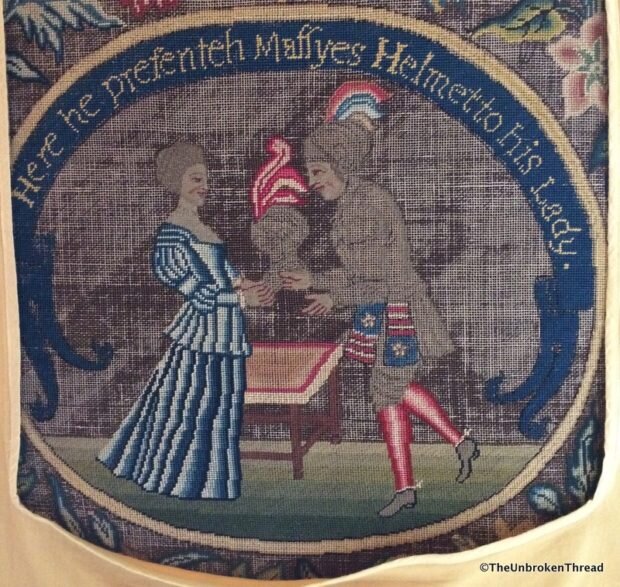 Only the backs of the chair were on view; the National trust had made covers so the seat and everything around the central stitched medallion is covered with a soft, protective chair cover.
Only the backs of the chair were on view; the National trust had made covers so the seat and everything around the central stitched medallion is covered with a soft, protective chair cover.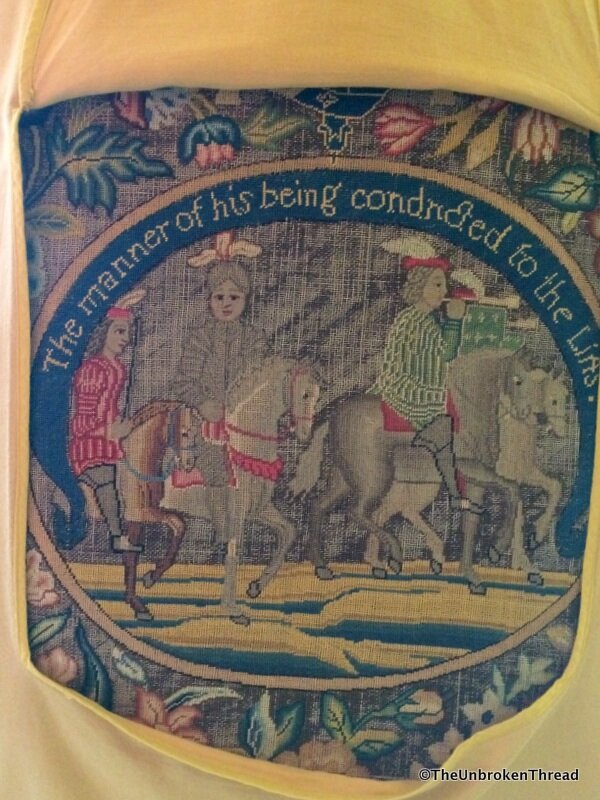 I found the detail in each of the pictures amazing. Look the the rosy cheeks of the herald on the left in the photo below!
I found the detail in each of the pictures amazing. Look the the rosy cheeks of the herald on the left in the photo below!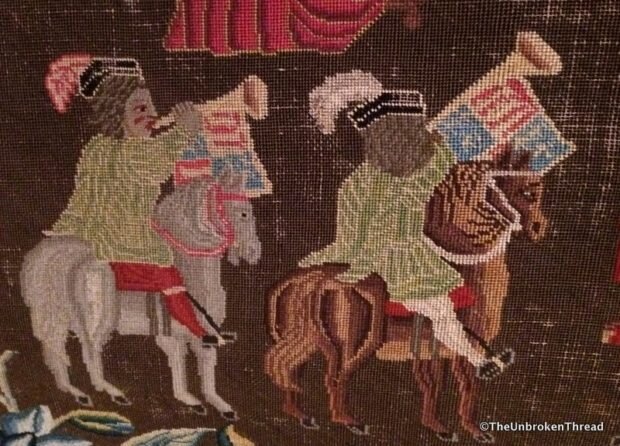 I spent a long time in the gallery, admiring the chairs and taking photos. And then I went around the corner and into a small room with three or four glass cases. In one case is a pair of gloves with gauntlets worked in gold. These kinds of pieces are among my favourite pieces of embroidery from the period. These kinds of embroidery gloves are so extravagant since they would have been carried, but rarely worn. There are many pairs of gloves in the V&A collection in London. Here is link if you're interested in seeing them.
I spent a long time in the gallery, admiring the chairs and taking photos. And then I went around the corner and into a small room with three or four glass cases. In one case is a pair of gloves with gauntlets worked in gold. These kinds of pieces are among my favourite pieces of embroidery from the period. These kinds of embroidery gloves are so extravagant since they would have been carried, but rarely worn. There are many pairs of gloves in the V&A collection in London. Here is link if you're interested in seeing them.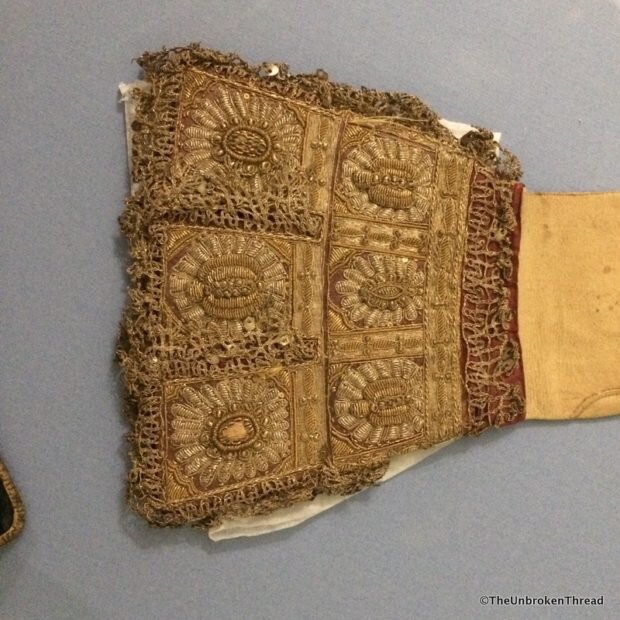 The ones I've seen previously are all beautiful and I admire the workmanship that's gone into making them, but these excited me for a different reason. According to the family story, these gauntlet gloves were worked by Queen Elizabeth I for John Astley, who was the husband of her governess and later close friend, Kat Astley/Ashley. Kat Astley/Ashley was imprisoned twice as a result of her loyalty to Elizabeth. If you want more information about the history, click here.These gloves are a direct connection with a history that I am intimately familiar with. I read voraciously about the monarchs of the Plantagenet and Tudor period and I devour everything I can about all the people who are part of the wider history of those periods. These gloves are part of that history!
The ones I've seen previously are all beautiful and I admire the workmanship that's gone into making them, but these excited me for a different reason. According to the family story, these gauntlet gloves were worked by Queen Elizabeth I for John Astley, who was the husband of her governess and later close friend, Kat Astley/Ashley. Kat Astley/Ashley was imprisoned twice as a result of her loyalty to Elizabeth. If you want more information about the history, click here.These gloves are a direct connection with a history that I am intimately familiar with. I read voraciously about the monarchs of the Plantagenet and Tudor period and I devour everything I can about all the people who are part of the wider history of those periods. These gloves are part of that history!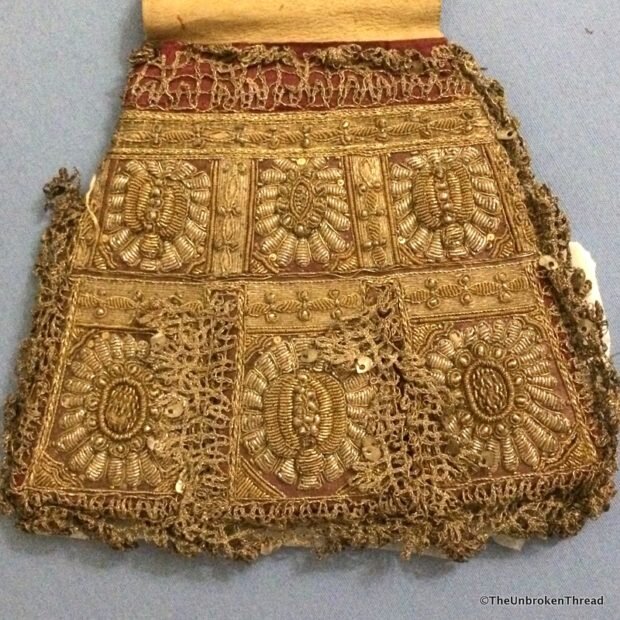 And then there's the exquisite goldwork! Note how the centre of the medallions are in an ABA pattern; in both rows the two on the ends are the same and the one in the middle is different.Here is a close up of some of the medallions. The quality of the photo is the best I could produce given that the gloves are under glass in a dim room. Just think of the hours and hours spent by Elizabeth embroidering these gloves, surrounded by her ladies, without electric light. It's well known that Elizabeth I was an outstanding needlewoman and here is proof!
And then there's the exquisite goldwork! Note how the centre of the medallions are in an ABA pattern; in both rows the two on the ends are the same and the one in the middle is different.Here is a close up of some of the medallions. The quality of the photo is the best I could produce given that the gloves are under glass in a dim room. Just think of the hours and hours spent by Elizabeth embroidering these gloves, surrounded by her ladies, without electric light. It's well known that Elizabeth I was an outstanding needlewoman and here is proof!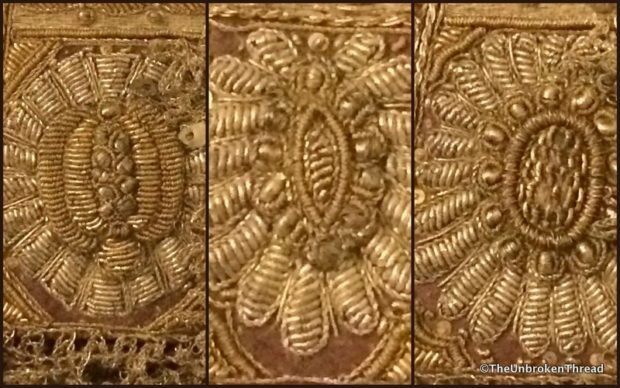 As I stood looking at the gloves and thinking about the lives of both John and Kat Ashley, I understood why the queen would have taken the time and used the precious materials to make a gift so extraordinary for her friend. It was the physical evidence of the gloves that brought alive the story of the sacrifices both John and Kat made for their queen and friend that moved me so much.It's these kinds of surprises that I love stumbling upon when we travel. I never know what piece of embroidery I'll find hidden in a house or museum!
As I stood looking at the gloves and thinking about the lives of both John and Kat Ashley, I understood why the queen would have taken the time and used the precious materials to make a gift so extraordinary for her friend. It was the physical evidence of the gloves that brought alive the story of the sacrifices both John and Kat made for their queen and friend that moved me so much.It's these kinds of surprises that I love stumbling upon when we travel. I never know what piece of embroidery I'll find hidden in a house or museum!
